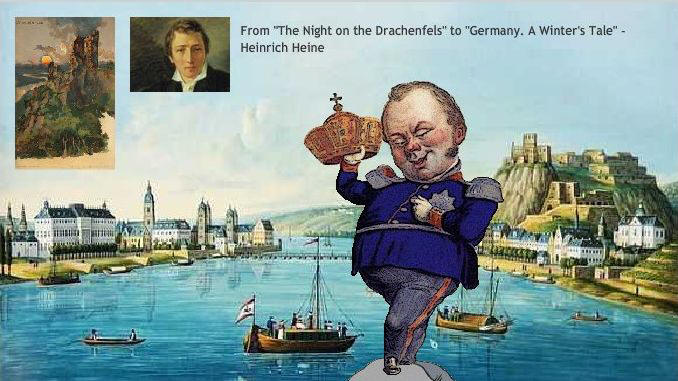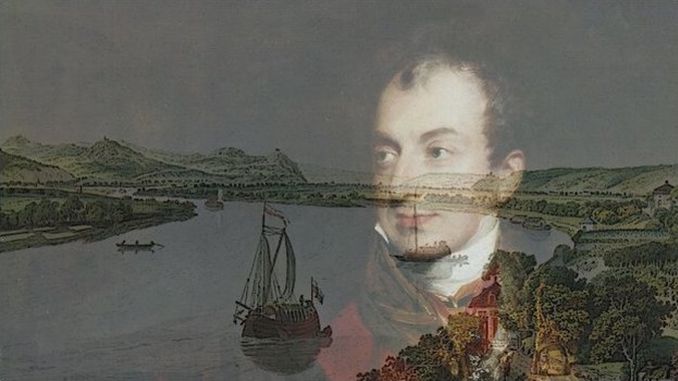
The Rhineland around 1815. After the Congress of Vienna, our region was part of the Prussian Rhine Province within the Kingdom of Prussia under Frederick William III (1797-1840).
Romantic Rhine and the Golden Age of Culture
The decades after the victory over Napoleon were a golden age of culture, art, and science.
Schinkel
Karl Friedrich Schinkel, the great architect and painter, gave us many buildings of “classic Berlin”. In addition, he took care of small and large buildings and monuments all over Prussia including the new Rhine province. In the Rhine valley, the King entrusted him with the restoration of Stolzenfels Castle near Koblenz.
Romanticism discovers from the Rhine
It was the time of the Romantic Rhine. Around 1820, the first steamboats cruised on the Rhine. A little later, one by one the railway lines appeared. Mount Drachenfels with the medieval ruin above inspired Lord Byron and Heinrich Heine, both dedicated it a poem.
Back then, the young Heinrich Heine was a student at Bonn University.
Drachenfels
At the beginning of the 19th century, the damages done to the Drachenfels had become alarming. In 1826, part of the walls of the ruin crumbled. Two years later the Prussian authorities ordered all the Drachenfels quarries closed. In 1829, the Drachenfels was classified as historical monument and thereby put under preservation order. In 1836, the Prussian Government bought the upper part of the Drachenfels with the ruin, for its protection.

Pre-March, a time of restoration
Yet, despite all beauty and Rhine romanticism, it was a time of political oppression and dire poverty. Therefore, we refer to the years between 1815 and 1848 as “time of restoration” or “Pre-March” (in German Vormärz), with regard to the March Revolution of 1848.
More than anyone else, the Austrian statesman Prince Metternich dominated this time. In his eyes, freedom of opinion, freedom of the press and freedom of assembly as well as the struggle for national unity meant agitation and a threat to security. Therefore, he and other princes oppressed them by might and main.
They prohibited the Burschenschaft student movement, who struggled for a unified German nation and a progressive, liberal political system. State authorities put professors and students under supervision, and censored newspapers and books. Suspicious persons were considered demagogues and prosecuted. Among them were men of great merits like the Prussian statesman and reformer Freiherr von und zum Stein, General Gneisenau and Professor Ernst Moritz Arndt from Bonn.
When Heinrich Heine’s poem “The Nacht auf dem Drachenfels” was published, his work was already censored.
1832 – hope for the liberals
The July revolution in France 1830 made a difference in Europe. On May 27, 1832, about 25,000 people from all circles of society, among them French, Polish and Italians, celebrated a national democratic festival on the Maxburg Castle in Hambach, Rhineland-Palatinate. Cheered by the crowd, the speakers demanded democratic rights and the fraternization of all free people. That was political dynamite.
New demagogue prosecutions began and censorship on literature became even stricter. After protesting against a breach of the constitution, seven highly respected professors of the university of Göttingen were expelled from the state of Hanover, among them the Brothers Grimm. In the 1830s, hundreds of people emigrated for political reasons to the United States.
Great need and emigration
The pre-march also was a time of great need. After 20 years of war, particularly the rural life was very hard. Many soils were ruined, the income was barely enough to live, there were almost no medical care and infant mortality was very high. In winter 1816/17, it came to a famine after several bad harvests. Hunger and despair drove many people away from their homes, in those years mass emigration to America began.
Home industry and early industrialization
After the end of the Napoleonic Wars, more and more industrial products from England came to Germany, and also here industrialization began, above all in the Rhine province. Back then, many people worked in the home industry, they made nails and knives, span and wove to make a living for themselves and their families. Also small-scale farmer families whose land did not feed them all earned money by working at home. But the home industry could not withstand industrialization. The more machines were developed and in use, the more people lost their work. One mechanical loom replaced 200 workers, that was a catastrophe for the weavers, and starvation wages, women or even child labor could not change anything. Many craftsmen impoverished, especially those whose products competed with industry.
Moreover, for centuries the guild system had over-regulated trade and thus inhibited progress and innovation. Only in the medium term, it could adapt to the new conditions, for example a shoemaker would repair industrially produced shoes rather than make new ones manually.
A time of pauperization
Countless impoverished peasants and jobless craftsmen moved into the industry cities, hoping to find work in the factories, what again forced down the wages. Working conditions were generally terrible, laws to protect the workers did not exist, and the conditions of living were disastrous. Despite strenuous art work, many people could not make a living for themselves and their families and became destitute. We speak of a time of pauperization.
Heine in exile
Poets and artists wrote about the great need and misery, among them Heinrich Heine in his “Weberlied”. Friedrich Engels translated it into English that soon was prohibited by the Prussian Government.
Since 1827, Heine’s work was censured, since 1833 it was forbidden in the State of Prussia, and thereby in his native Rhineland. Heine had left Germany in 1831, to spend the remainder of his life in France. He only once came back, in 1843, and he wrote “Deutschland. Ein Wintermärchen” (Germany. A Winter’s Tale).
Mass emigration to the United States
After poor harvests in the years 1845 and 1846 there was a great famine in 1847. The communities did not have the means to help needy families. For many people in need, emigration was an option worth considering. Since 1820, the number of emigrants increased. In the years from 1845/1847 until 1855 the biggest mass emigration of the 19th century to North America occurred, 80,000 people alone in 1847.
Kingdom of Prussia and German Reich
Intro Prussian Rhineland | Prussian Rhine Province | Revolution 1848/49 | Bismarck Era | Wilhemine Era

Be the first to comment